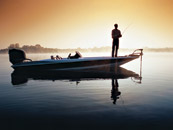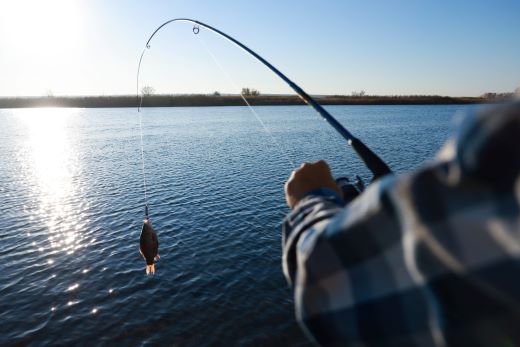The word “flyfishing” to many brings to mind bucolic scenes of men in waders standing in a river gorge. But those who know the sport also know that flyfishing from aboard a boat can be even more fun and equally relaxing. Because of the casting motion required, most boat-based flyfishing is done from flats boats and skiffs that have shallow drafts, allowing them to enter the lagoons and backwaters. But many anglers like the challenge of chasing larger game on fly, such as pike.
- Getting started in fly beings with a balanced flyfishing rod, reel and line outfit. The assembled rig should feel balanced in your hand. While holding the grip the rod shouldn’t feel butt or tip heavy. This will make for comfortable, controllable fly fishing. Most rods are made of graphite, but you will sometimes see other materials.
Unlike other types of angling, flyfishing starts by choosing the line most appropriate for the type of fishing you’ll be doing, then matching it to a rod and then a reel.
- For medium fish, such as trout and bass, most people choose 5-, 6- or 7-weight line. For this size a rod 8 to 9 feet in length is average. Longer rods are easier to cast and can cast longer distances. A fly reel holds the fly line and generally you won’t need any special features on your reel for fishing this class.
- Large trout and bass generally require 7-, 8- or 9-weight line, and a rod of 9 to 10 feet. Look for a reel with a palming rim and drag system. Some anglers like a disc-drag system for these bigger fish.
- Really big fish, like pike, are usually fished with 12-weight lines and 9 to 10 foot, 12-weight rods. With big fish, a palming rim and a really good disc drag system is helpful. Look for a big reel with heavy drag and large line and backing capacities.
To compete the basic flyfishing outfit you’ll need backing, fly line, leader and a tippet. Backing is heavier line that is the first line wound onto your reel. It is not the line that is cast. It serves two purposes: to fill the spool so it doesn’t take forever to wind in a fly line and to allow a fish to run and strip more line from the reel than the fly line itself. Backing becomes more important when you’re chasing larger prey. You’ll need anywhere from 500 to 300 yards of backing depending on your prey. The fly line is the monofiliment that is cast. Most fly lines are only around 90 feet in length. The leader and tippet are at the end of the line, connected to the lure. This is basically chosen according to fly sizes to be fished.
Of course you’ll also need hooks and lures or bait. There are volumes written on these subjects and they are the topic of excellent conversation among anglers.


